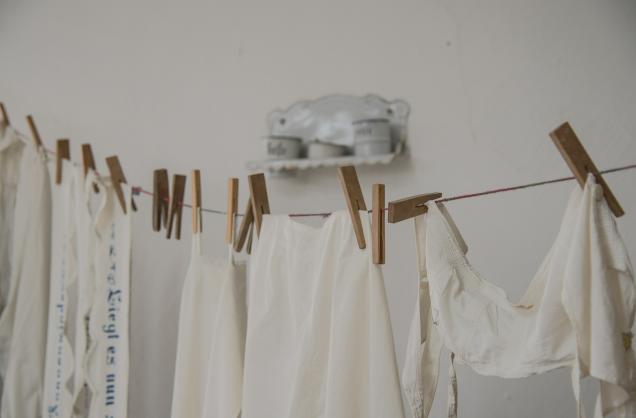
Bleaches help whiten, brighten and remove stains. Here's how to use bleach on clothes:
Bleach converts soils into colorless, soluble particles which are easily removed by detergents, then carried away in the wash water. Bleach can also brighten and whiten fabrics and help remove stubborn stains.
Sodium hypochlorite bleaches (also called chlorine or liquid household bleach) are the more powerful laundry bleaches; they disinfect, as well as clean and whiten. They work on many whites and colorfast washables - but not on wools or silks. Oxygen (color-safe) bleaches are gentler, working safely on all washable fabrics. They work best in maintaining whiteness, not in restoring it.
For Sodium Hypochlorite Bleach, read the label and dilute as directed. For best results, add 5 minutes after the wash cycle has begun to agitate in order to avoid destroying enzymes and fluorescent whiteners in the detergent.
For Oxygen Bleach, add directly to the wash water before the clothes are added. Do not pour powdered bleach directly on wet clothes. Oxygen bleaches are most effective in warm-to-hot water.
Using Bleach to Remove Stains on White Clothes
IMPORTANT: Read the fabric care label first! The fact that the item is white doesn’t necessarily guarantee that it’s safe to use bleach, especially chlorine bleach. Factors such as the fabric’s fiber content (including silk, wool, mohair and spandex), finishes (such as the flame-retardant finish on children’s nightclothes) and certain trims will affect the item’s suitability for bleach.
If bleach is a no-no and there are stains, pre-treat them with a pre-wash stain remover, check the cleaning product label first to make sure it is safe for the fabric, or presoak the item, using detergent or a presoak laundry product that’s safe for the fabric. Mix the soaking agent with water, and then add the item. Minimum soaking time is 30 minutes; longer, as much as overnight, may be necessary.
If bleach is safe for the fabric, follow the tips below.
Tips for Using Bleach in Laundry
1. Read the Label: Check the garment label before laundering; some fabrics cannot be washed using liquid household bleach (sodium hypochlorite). If liquid household bleach is not recommended, you can use a color-safe (oxygen) bleach to help remove stains and odors. Also read the cleaning product label. Some detergents have color-safe bleach or bleach alternative built into the product. However, remember that these products do not disinfect.
2. Test: Dip a cotton swab in the bleach/water solution and dab on an inside seam. If the fabric color remains, then you should be safe.
3. Start small: Lay the stained section of the garment flat and be sure there not layers of fabric or anything underneath that can be affected. Work from the outer edge of the stain in, rinse with fresh water when the stain is gone.
4. Bleaching the whole load: Read the label on the bleach product to determine the amount to use when adding bleach to an entire load of laundry. Consult your washing machine use manual to see if you should add the bleach to the drum or to a special dispenser drawer or section.
Chlorine bleach can be used to disinfect and sanitize laundry and well as kitchen, bathroom and other surfaces around the home. Disinfectants and disinfectant cleaners are the only products that kill germs—but they only work if the label directions are followed. Products that claim to kill germs must meet efficacy requirements and guidelines established by the U.S. Environmental Protection Agency (EPA), and must be registered with EPA and carry an EPA registration number on their label.
Safety Reminders:
- Read and follow label directions at all times.
- Never mix chlorine bleach or any product containing chlorine bleach with ammonia, ammonia-based products or acidic products. The combination can be dangerous… or even deadly.